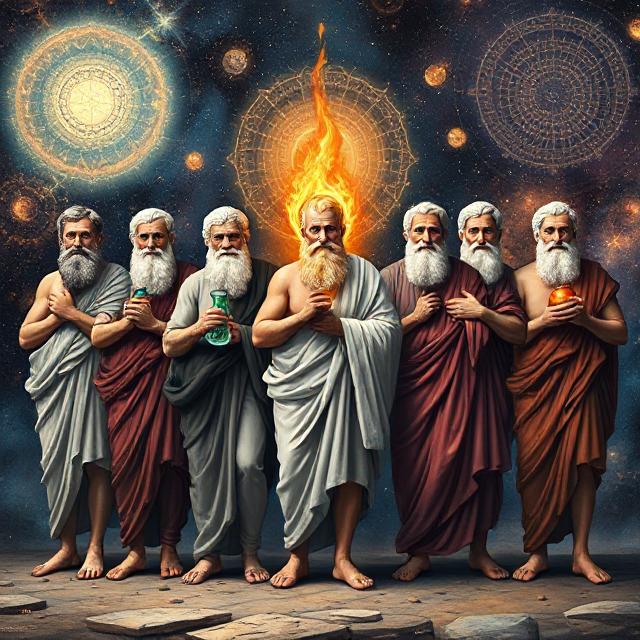
Table of Contents
Pre-Socratic Beliefs: Origins of Western Thought
Before Socrates ever posed his famous questions in the agora of Athens, a diverse group of thinkers were already asking bold questions about the nature of reality, knowledge, and existence. These early thinkers are called the Pre-Socratics, not because they were unimportant, but because their work predates Socrates and laid the groundwork for his revolutionary method.
This article explores Pre-Socratic beliefs, including their metaphysical inquiries, natural explanations, and emerging notions of logic and reason—ideas that would influence philosophy, science, and cosmology for millennia.
I. Who Were the Pre-Socratics?
The Pre-Socratic philosophers were active roughly between 600 BCE and 400 BCE, mostly in the Greek-speaking world, particularly Ionia (Asia Minor), southern Italy, and mainland Greece. While Socrates focused on ethics and epistemology through dialogue, the Pre-Socratics were primarily cosmologists—they wanted to understand what the world is made of and how it works.
Some key Pre-Socratics include:
- Thales
- Anaximander
- Anaximenes
- Pythagoras
- Heraclitus
- Parmenides
- Empedocles
- Democritus
- Zeno of Elea
Their beliefs varied greatly, but they all shared one revolutionary idea: the world is intelligible through reason and observation—not just myth or religion.
II. Thales: Everything Is Water
Often called the father of Western philosophy, Thales of Miletus (c. 624–546 BCE) proposed that the fundamental substance (or archê) of everything is water. His reasoning was rooted in observation:
- Water is essential for life.
- It can take different forms—liquid, gas, solid.
- It’s found everywhere.
Thales also predicted a solar eclipse and used geometry to measure pyramids, showing that rational tools could decode the natural world.
III. Anaximander: The Boundless (Apeiron)
A student of Thales, Anaximander (c. 610–546 BCE) disagreed that any known substance could be the fundamental element. Instead, he proposed the apeiron—an indefinite, boundless substance that underlies everything.
He believed:
- The apeiron is eternal and contains all opposites.
- From it, the cosmos emerges and returns.
- Natural phenomena have mechanical explanations (e.g., Earth floats due to symmetry).
This was a radical shift from divine myths to naturalistic, abstract cosmology.
IV. Anaximenes: Air as the Primary Substance
Anaximenes (c. 586–526 BCE), another Milesian, returned to a tangible element and proposed that air is the fundamental substance.
- Air becomes fire when rarefied, wind and clouds when condensed, and eventually water and earth.
- He introduced the concept of quantitative transformation—a proto-scientific idea.
This marked a step toward materialist monism: the idea that everything derives from a single, observable substance.
V. Heraclitus: Everything Flows
Perhaps the most poetic of the Pre-Socratics, Heraclitus of Ephesus (c. 535–475 BCE) believed that the fundamental nature of reality is change.
- “You cannot step into the same river twice.”
- The world is in constant flux (panta rhei).
- Fire is the primary substance, symbolizing transformation.
- He introduced logos: a rational principle that governs the cosmos.
Heraclitus emphasized tension between opposites—a precursor to dialectical reasoning.
VI. Parmenides: Change Is an Illusion
In stark contrast to Heraclitus, Parmenides of Elea (c. 515–450 BCE) argued that change is impossible and all is one:
- Being is eternal, unchanging, and indivisible.
- Change implies non-being, which is illogical.
His philosophy introduced pure deductive reasoning into metaphysics. While his claims seem counterintuitive, they sparked fierce debates that would shape ontology and logic.
VII. Zeno: Paradoxes of Motion
A student of Parmenides, Zeno of Elea (c. 490–430 BCE) supported his teacher with paradoxes:
- Achilles and the Tortoise
- The Arrow Paradox
- The Dichotomy Paradox
These paradoxes challenge the notion of space and time by showing that motion leads to logical absurdities under certain assumptions. His work laid the groundwork for later developments in mathematics and infinity theory.
VIII. Empedocles: Four Elements
Empedocles (c. 494–434 BCE) attempted to reconcile change and stability:
- All matter consists of four roots: earth, air, fire, water.
- These combine and separate under the influence of Love and Strife.
This dynamic model explained growth, decay, and mixing. It prefigured later ideas in chemistry and medicine.
IX. Democritus: The Atomist
Democritus (c. 460–370 BCE) offered the first fully developed atomic theory:
- Everything is composed of tiny, indivisible units: atoms.
- Atoms differ in shape, arrangement, and motion.
- They move in the void, combining to form objects.
Though dismissed in his time, Democritus’ ideas foreshadowed modern physics. His materialism also challenged spiritual or mystical interpretations of the cosmos.
X. Common Threads in Pre-Socratic Beliefs
Despite their differences, the Pre-Socratics shared key ideas:
- Naturalism: Explanations based on nature, not gods.
- Unity: A search for a single principle or substance.
- Reason over myth: Trust in logic and observation.
- Curiosity about change, motion, and permanence.
These themes marked a profound shift—from storytelling to systematic inquiry.
XI. Influence on Later Philosophy
The Pre-Socratics inspired Plato, who synthesized Heraclitus’ flux and Parmenides’ unity through his theory of Forms.
Aristotle built a taxonomy of causes and developed logic to address problems raised by Zeno and others.
Their thought also prefigured:
- Stoicism’s logos
- Atomist theories in Enlightenment science
- Contemporary metaphysics and philosophy of science
XII. Conclusion: Why Pre-Socratic Beliefs Still Matter
Pre-Socratic beliefs may seem speculative or archaic, but they represent the birth of rational inquiry. These thinkers dared to ask what the world is made of and how it changes. They sought unifying principles, wrestled with logic, and trusted that nature, not myth, held the answers.
In doing so, they carved the first path through the forest of confusion—and began the long journey of philosophy.
